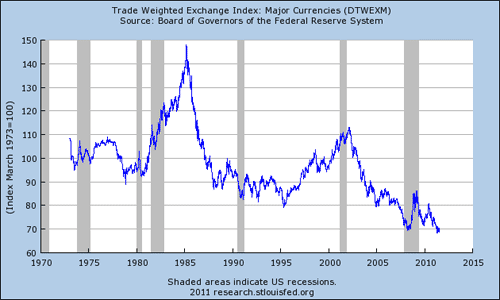For fifty years, the United States government has followed a policy of credit inflation. And, I am blaming both parties…the (Keynesian) Democrats and the (“we’re all Keynesians now”—Richard Nixon) Republicans.
The current discussions going on in Washington, D. C. don’t really give me much hope for the future. Congress and the White House may talk about reducing deficits now, but both sides of the talks don’t seem to have any idea about creating a sustainable government policy with respect to the creation of federal debt.
As I have reported before, since January 1961, the public debt of the United States has increased at a compound rate of growth in excess of 8 percent per year. This has resulted in the public debt now being in the neighborhood of $14 trillion.
Over the past two years, I have argued that in the next ten years, the federal debt will at least double from its current level. If we cut the deficit by $4 trillion…or $3 trillion…or $2 trillion…figures that have been tossed around in the current debates…we will still add massive amounts to the existing debt levels.
This amount of debt, I don’t believe, is sustainable even after these cuts.
Why has the United States government amassed so much debt during this time period?
The reason is that the number one goal of the government’s economic policy has been to achieve high levels of employment…low levels of unemployment.
As I have written elsewhere, the achievement of this goal is impossible. And, all the government’s efforts to attain this objective have just resulted in making the employment situation worse. Not only has the official unemployment rate been greater than the target unemployment rate for this period, the level of under-employment in the United States has risen to the point where about one in five people of working age are underemployed…either unemployed, employed part time but want to be employed full time, or have dropped out of the labor market.
So, the federal government has followed a policy of credit inflation for fifty years and has not only not achieved its goal but has made the employment situation much worse.
In addition, the policies of the federal government have resulted in a tremendous skewing of the income/wealth distribution in the United States away from those earning the least and in favor of those earning the most. This was certainly not something desired by the perpetrators of these policies.
Wasn’t there any indication that something was wrong?
In my view there was some very clear evidence that something was wrong. The value of the United States dollar against other currencies in the world has been an indicator that investors throughout the world thought that the economic policies of the United States government were not sound and that there was little or no hope that the United States government would re-establish any discipline over its budgeting process. The feeling was that as long as the United States continued to pursue the effort to achieve full employment, fiscal discipline would be ignored.
My argument is that the United States has followed an explicit policy of credit inflation since the early 1960s. The period began with the value of the United States dollar pegged against gold. However, the credit inflation of the 1960s brought this to an end as President Nixon took the dollar off the gold standard on August 15, 1971 and floated the dollar in the foreign exchange market.
Since then, the trend has been downward. This is shown in the following chart.

There are two exceptions to the downward movement in the value of the dollar. The first is the Volcker monetary tightening coming in the early 1980s which resulting in the short term peak in the value of the dollar in February 1985. The second is the Rubin fiscal tightening that took place in the late 1990s with the near term peak in the dollar’s value occurring in July of 2002.
Otherwise we have the following results:
Measured from January 2, 1973, the value of the dollar has declined by around 37 percent to the present;
Measured from the its peak value in February 1985, the value of the dollar has declined by about 54 percent;
Measured from its peak value in July 2002, the value of the dollar has declined by almost 40 percent;
Measured from the “flight to quality” peak value during the recent financial crisis in March 2009, the value of the dollar has declined by over 20 percent.
Although the value of the dollar rose during the first European sovereign debt crisis in 2010, it has declined almost constantly during the most recent problems.
International financial markets don’t think much of the economic policies of the United States government. And, the basic reason the United States has been able to get away with this total lack of discipline has been that the United States currency is the reserve currency of the world.
Now, I am not one that believes that the budget of the United States government has to be balanced at all times or even over time. I do believe that fiscal discipline must be established so that credit inflation is kept under control. Over the past fifty years, the real compound growth rate of the United States has been slightly more than 3 percent. If the government could constrain its budget so that the public debt and the economy grew at no roughly in line with one another, I think the country could live with that and credit inflation would not be a major problem.
However, I don’t see our current crop of politicians capable of exhibiting such discipline.



Leave a Reply